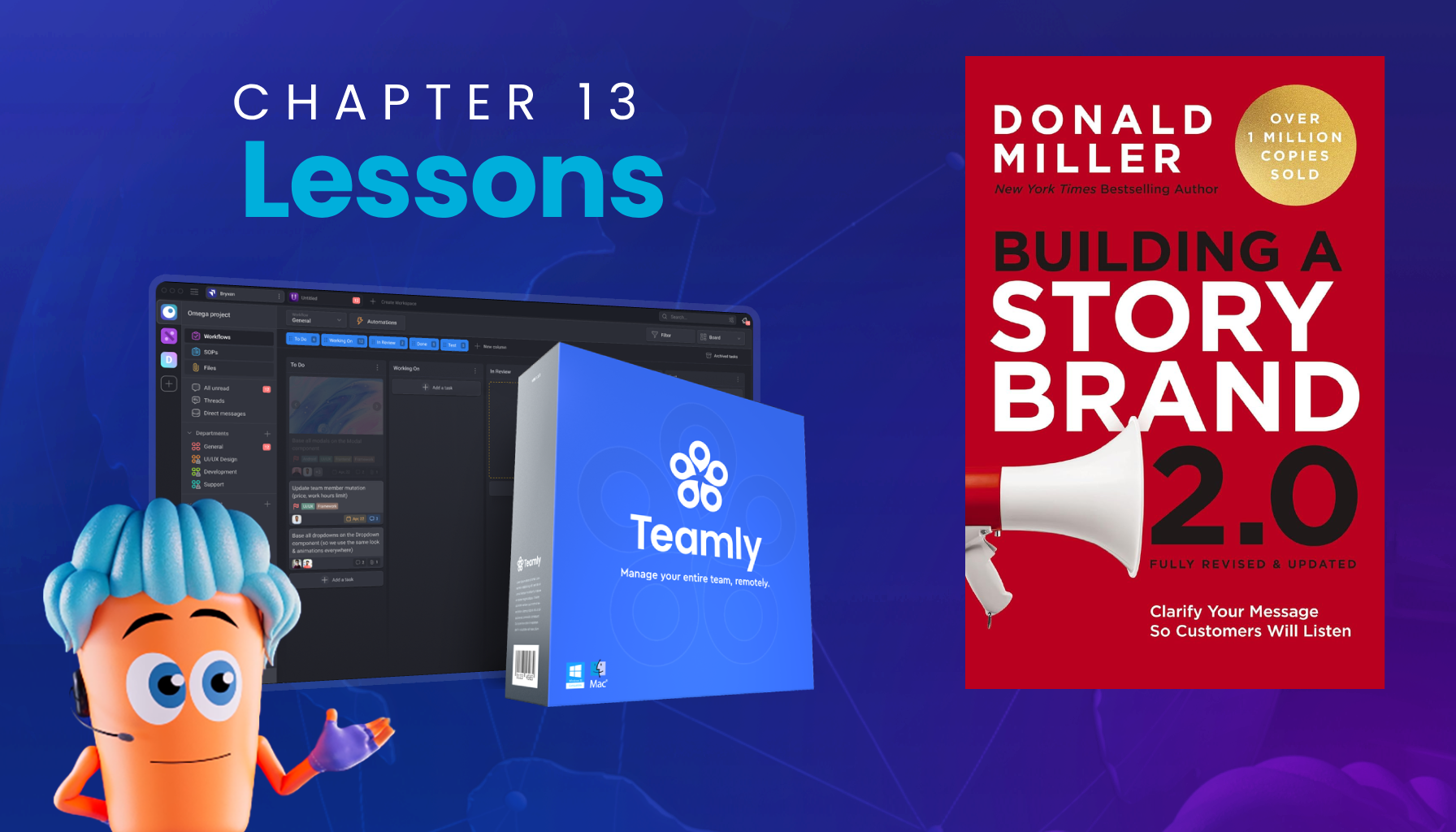
Click the button to start reading
Key Lessons from Building a StoryBrand 2.0: Chapter 13
Chapter 13 of Building a StoryBrand 2.0 offers a concise yet powerful framework for brands looking to resonate more deeply with their customers.
At its core, the chapter introduces a straightforward three-step process. While the method is simple to outline—create, refine, and repeat—each step involves deliberate effort to stand out in a cluttered marketplace.

Why Brand Messaging Matters More Than Ever
According to author Donald Miller, many brands have excellent products or services, yet their marketing fails to pique real interest.
It isn’t enough to assume quality will automatically attract customers. People need a clear explanation, stated in a way that triggers a sense of immediate relevance.
Clarity is the main ingredient. Without it, even a brilliant offer remains invisible. Take a moment to consider how many sales pitches and advertisements flash by each day—studies show that 90% of these are tuned out.
Audiences must see or hear a core message multiple times before it sticks.
That’s precisely why Chapter 13 compares a well-orchestrated branding effort to a political campaign. When a candidate runs for office, they use repeatable talking points. These points drill down on a problem, offer a plan, and propose a better future.
The candidate might be intelligent, but if the message never becomes sound bites, people move on. The same principle applies to every business.
The Presidential Candidate Example
Donald Miller recounts helping a prominent presidential candidate who started with strong advantages: national recognition, a large campaign chest, and a strong political résumé.
Despite an early lead, the campaign began losing ground. The problem, as Miller noted, was that the candidate’s message wasn’t landing. He resisted “sound bites” because he preferred long-form, scholarly discussions about policy.
From a policy standpoint, this was admirable. However, mass audiences rarely have the time or patience to sift through dense arguments.
The result? The campaign’s carefully crafted policy papers never broke through the media chatter. Voters started tuning out.
Brands often face a similar dilemma. A product can be amazing, but if the public can’t grasp the core benefit in seconds, they might never engage. Chapter 13 highlights that a brand must be both clear and repetitive, or it risks staying in the shadows.

The Myth: “If You Build It, They Will Come”
Chapter 13 dismantles the notion that a great product automatically wins. It references how business owners can pour their hearts into design and innovation, only to be met with silence at launch.
Why? Because consumers, swamped with choices, have no clue why a product should matter to them.
In many cases, marketing content is either too vague or too sophisticated for a first impression. People can’t figure out what is being sold or the difference it makes.
Miller points out that you may need to share your primary message dozens of times for potential buyers to notice.
He suggests that hearing the same message eight times is the minimum for it to register. Given how often consumers get distracted, you might need to circulate that message as many as 80 times.
Repetition isn’t a marketing trick; it’s basic psychology. Our brains latch onto information that’s familiar. The more consistently your brand shares a simple story, the more embedded it becomes in your audience’s minds.
The Three Steps to a Flawless Messaging Campaign
Chapter 13 distills the formula for successful messaging into three steps. These apply whether a company is small or sprawling. Mastering each step builds a consistent narrative that customers instantly recognize.
- Create Your StoryBrand BrandScript
At the root of StoryBrand is the BrandScript. This outlines the customer as the hero, identifies their core problem, highlights how your brand empathizes with that problem, and provides a plan to overcome it.
In essence, the BrandScript transforms an abstract idea into a tangible story arc.
This is crucial because many businesses mistakenly spotlight themselves as the hero. Customers, however, want a guide who helps them solve their own challenges. A BrandScript ensures the conversation stays customer-centric.
Miller’s guidance emphasizes empathy plus authority. Show you understand the customer’s struggle and prove you can fix it. Then position your brand as the expert ready to come alongside, not as the main star overshadowing the customer.
Clarity is the golden rule. Flashy slogans can be fun, but if they obscure the product’s true purpose, they can derail the entire campaign. So keep phrases simple and direct.
Think “We fix your scheduling headaches in one easy step” over a vague statement like “Innovating tomorrow’s synergy.”

- Edit Your Sound Bites Until They Get the Reaction You Want
Once the BrandScript is set, the next move is to distill it into sound bites. These short, punchy lines ensure people instantly grasp how your brand helps them.
Chapter 13 provides a simple test: If, after hearing your short pitch, the listener asks “How can I buy?” or “Where can I learn more?”, then the sound bites are working.
If they respond with “I don’t get it” or “Wait, could you say that again?”, it’s time to refine. Miller encourages brands to test these sound bites in real conversations. Watch people’s facial expressions. Note whether they seem intrigued or confused.
Too often, businesses get attached to phrases that feel clever but fall flat in practice. Miller reminds readers not to grow so fond of a tagline that you ignore the market’s feedback.
The goal is a quick, visceral response: “That’s exactly the problem I have, and I need what you’re offering.”
This step is also where many organizations discover that less is more. The most effective marketing statements tend to be shorter.
They anticipate the customer’s frustration and show how the brand can resolve it. Burying potential buyers in too much detail can slow them down.
- Repeat Your Sound Bites Until the Public Memorizes Them
Even the best-crafted message won’t stick unless it’s heard again and again. Chapter 13 likens a brand’s messaging effort to memorizing a poem.
If each recital changes the words, no one ever learns it. Consistency is key: always use the same phrasing, so your target audience hears—and remembers—your core promise.
Miller uses a personal anecdote: he created a binder of classic poems with a monetary reward for his wife’s baby sister each time she memorized one. This approach highlights how repetition leads to recall. In business, the “reward” for your customers is an easy grasp of the benefit you deliver.
Repetition should be woven into every marketing channel. Websites, social media, email newsletters, and even live sales conversations should echo the same short, purposeful lines. If a brand tries new wording all the time, customers won’t know what to latch onto.

Putting the Three Steps Into Action
With the BrandScript complete, the sound bites honed, and a plan to repeat them often, the next task is deployment.
The final pages of Chapter 13 explain how to embed this clear message into websites, ads, landing pages, and lead generators. Audiences shouldn’t have to guess what a brand does or how it helps them.
Miller points out that strong messaging transforms other projects, too. Sales scripts, for instance, become straightforward.
Instead of guesswork, the sales rep shares the same consistent lines. The brand’s social media team also uses identical language, further anchoring the story in people’s minds.
This alignment across departments is crucial. Everyone from operations to customer support should know the brand’s simple promise and who the real hero is.
For instance, consider a technology platform like Teamly. If each department understands the core story—helping businesses streamline workflows—everyone can reinforce that same message.
Real-World Results
Companies that embrace the three-step process often see a spike in brand recognition. Prospects become more likely to remember that specific brand when a relevant need surfaces.
The clarity also improves marketing ROI, because each campaign is consistent with the main story.
It’s a shift that can lift the entire operation: employees feel confident explaining what they do, managers spot new ways to reinforce the story, and customers receive consistent signals at every stage of their journey.
Even existing clients can become brand advocates once the central promise is clear in their minds.
Miller reminds readers that while these steps take time, they’re non-negotiable for long-term success.
A brand that invests the energy to craft a strong script, refine it into concise statements, and repeat them with dogged consistency will outpace those that rely on a “build it and they will come” mentality.
Get a copy of the book here:–> Building a StoryBrand 2.0
















